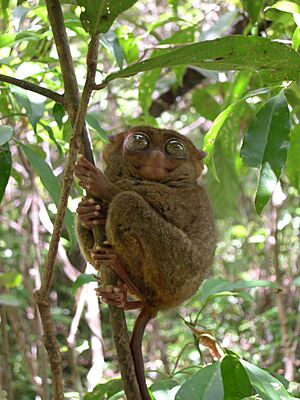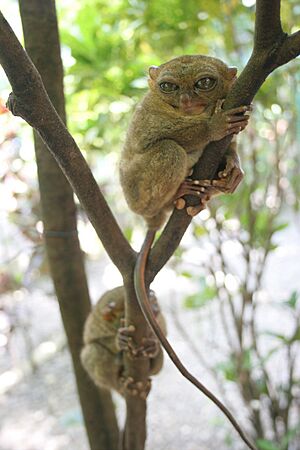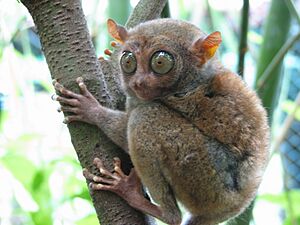Philippine tarsier facts for kids
Quick facts for kids Philippine tarsier |
|
|---|---|
 |
|
| Conservation status | |
| Scientific classification | |
| Genus: |
Carlito
|
| Species: |
syrichta
|
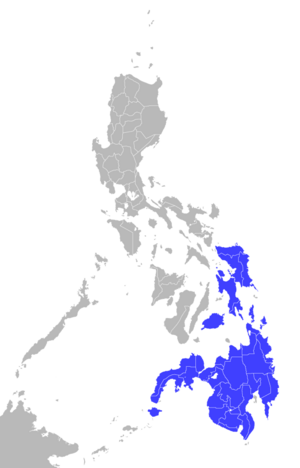 |
|
| Geographic distribution of Philippine tarsier | |
| Synonyms | |
|
|
The Philippine tarsier (Carlito syrichta) is a tiny primate found only in the Philippines. Locals call it mawumag in Cebuano and magô in Waray. It lives in the southeastern part of the Philippines, especially on the islands of Bohol, Samar, and Leyte.
This small animal belongs to a very old family of primates called Tarsiidae. Its name comes from its long "tarsus" or ankle bone. The Philippine tarsier used to be in the genus Tarsius. But now, it is the only member of a new genus called Carlito. This genus was named after Carlito Pizarras, a person who works to protect these animals.
You can also find Philippine tarsiers on Maripipi Island, Siargao Island, Basilan Island, and Dinagat Island.
Contents
About the Philippine Tarsier
The tarsier gets its name from its very long ankle bone, called the "tarsus." This special bone helps it jump far. The genus name Carlito honors Carlito Pizarras, a conservationist.
In different parts of the Philippines, people have other names for this animal. These include mamag, magau, malmag, and magatilok-iok.
How Tarsiers Are Classified
The Philippine tarsier is the only species in the genus Carlito. It is part of the Tarsiidae family. Scientists recognize three types, or subspecies, of the Philippine tarsier:
- Carlito syrichta syrichta: found on Leyte and Samar islands.
- Carlito syrichta fraterculus: found on Bohol Island.
- Carlito syrichta carbonarius: found on Mindanao Island.
Changes in Its Scientific Name
For a long time, all living tarsiers were grouped under the genus Tarsius. However, in 2010, scientists decided that the Philippine tarsier was special enough to have its own genus, Carlito.
The first time Western scientists learned about the Philippine tarsier was in the 1700s. A missionary named J.G. Camel described it. This description helped Linnaeus give it its first scientific name, Simia syrichta, in 1758. This name later became Carlito syrichta, which is its current scientific name.
Body and Appearance
The Philippine tarsier is one of the smallest primates. It measures about 8.5 to 16 centimeters (3.3 to 6.3 inches) tall. This small size makes it hard to spot in the wild. Males usually weigh between 80 and 160 grams (2.8 to 5.6 ounces). Females are often a bit lighter. An adult tarsier is about the size of a human fist.
A baby tarsier is born after about 6 months of pregnancy. Only one baby is born at a time. Newborns have a lot of fur and their eyes are open. Their body and head are about 7 cm (2.8 in) long, and their tail is around 11.5 cm (4.5 in) long.
Like all tarsiers, its eyes are fixed in its skull. This means they cannot move their eyes. Instead, they can turn their round head almost all the way around, up to 180 degrees! Their eyes are huge compared to their body. They have the largest eye-to-body weight ratio of all mammals. These big eyes help them see very well at night. In bright light, their pupils become very thin. In the dark, they open wide to let in more light.
Their large, thin ears move constantly. This helps the tarsier hear even the smallest sounds.
The Philippine tarsier has thin, rough fur that is gray to dark brown. Its narrow tail is bald except for a tuft of hair at the end. The tail is about twice as long as its body and helps it balance. Its long ankle bone, the "tarsus," allows it to jump at least 3 meters (10 feet) from tree to tree. Its long fingers and toes have rounded pads. These pads help it cling easily to trees and other surfaces. All its digits have flat nails, except for its second and third toes. These toes have sharp claws used for grooming.
Tarsiers have a specific set of teeth. They have 2 incisors, 1 canine, 3 premolars, and 3 molars on the top jaw. On the bottom jaw, they have 1 incisor, 1 canine, 3 premolars, and 3 molars. Their upper canine teeth are quite small.
Ecology and Habitat
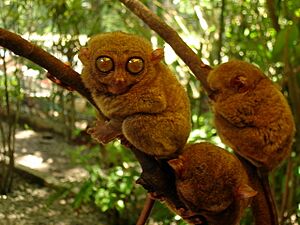
The Philippine tarsier mainly eats insects. Its diet includes spiders, small crustaceans, and small animals like lizards and birds. They love to eat crickets and grasshoppers. When a tarsier catches prey, it uses both hands to bring it to its mouth.
Where Tarsiers Live
As its name suggests, the Philippine tarsier lives only in the Philippines. Most populations are found in the southeastern part of the country. They live mainly on the islands of Bohol, Samar, Leyte, and Mindanao. They have also been found on smaller islands like Maripipi, Siargao, Basilan, and Dinagat.
Philippine tarsiers live in forests. They prefer tropical rainforests with thick plants and trees. These include tall grasses, bushes, and bamboo shoots. They like dense, low-level plants in secondary forests. They usually perch about 2 meters (6.6 feet) above the ground.
Tarsiers need a lot of space to live. Males need about 6.45 hectares (16 acres), and females need about 2.45 hectares (6 acres).
What Hunts Tarsiers?
Besides humans, feral cats from nearby towns are a big threat to tarsiers. Some large birds, like owls, also hunt them. Because tarsiers are active at night and live in trees, they are most likely to be caught by owls or small meat-eating animals that climb trees.
Behavior and Life Cycle
The Philippine tarsier is a shy, nocturnal animal. This means it is active at night. During the day, it sleeps in dark, hidden spots close to the ground. These spots are usually near tree trunks and shrubs deep in the forest. At night, its excellent eyesight and ability to move through trees help it avoid humans.
Tarsiers are arboreal, meaning they live in trees. They cling vertically to trees and can leap from branch to branch.
Philippine tarsiers are usually solitary. This means they live alone. However, sometimes they might meet other tarsiers at night.
How Tarsiers Communicate
Tarsiers make different sounds to communicate. One is a loud, piercing call. Another is a soft, sweet, bird-like sound, which means they are content. When several tarsiers are together, their chirping sounds like locusts.
These animals can also make sounds that humans cannot hear, called ultrasound. They can hear very high frequencies, above 90 kHz. Baby tarsiers use ultrasound as a distress call if they get separated from their mothers. Males also use it to call to females during mating season.
Tarsiers also communicate using smells. Females use a scent from a gland around their mouth to mark their mates. Males mark their territory with their urine. They also communicate by grooming each other. This means they clean each other's fur, removing dead skin and parasites. Females often groom adult males and their babies.
Reproduction and Life Cycle
A female Philippine tarsier is pregnant for about six months. Her estrous cycle (when she can get pregnant) lasts 25–28 days. The mating season is usually from April to May. The female gives birth to only one baby at a time.
Newborn tarsiers are born with fur and their eyes open. The mothers carry their babies in their mouths. A newborn can cling to branches right away. In less than a month, it can start leaping on its own.
Babies drink their mother's milk for about 60 days. After two years, a tarsier is old enough to have its own babies.
Conservation Status
The Philippine tarsier has faced many threats. In the past, it was listed as endangered by groups like the IUCN Conservation Monitoring Centre and the Department of Environment and Natural Resources.
In 2008, the IUCN changed its status to near threatened. This means that while it's not endangered yet, its numbers have dropped a lot over the last 20 years. This is mainly because of habitat loss and illegal hunting for the pet trade.
The Philippine tarsier is also listed in Appendix II of CITES, which controls international trade of endangered animals. The U.S. ESA also lists it as threatened.
There is a special place called a tarsier sanctuary in Corella, Bohol. The Philippine Tarsier Foundation runs it. It has a visitor center and a natural forest area of about 7,000 square meters (1.7 acres) where tarsiers can live safely.
Threats in the Wild
Tarsiers have lived in rainforests for millions of years. But now, they are found on only a few islands in the Philippines, Borneo, and Indonesia. In Bohol, tarsiers were common until the 1960s. Now, there are only about 700 left on the island, according to the Philippine Tarsier Foundation.
The biggest threat to tarsiers is the growing human population. More and more forests are being turned into farms, houses, and roads. This means the tarsier's natural home is disappearing. Illegal logging, cutting trees for firewood, and slash and burn farming (called kaingin) also destroy their habitats.
Interestingly, some local tribes, like the B'laans and T'bolis, have helped protect tarsiers. They believe these animals can bring bad luck, so they leave them alone in the wild. This belief, along with thick rainforests, has helped tarsiers survive in some areas.
Why Tarsiers Don't Do Well in Captivity
Tarsiers are often caught to be sold as pets or for trade. However, they usually do not survive long outside their natural home. They need to eat live insects, which is hard to provide in captivity. Places that display captive tarsiers, like in Loboc, Bohol, can also harm the animals. Some people worry that seeing captive tarsiers might make tourists want to buy them illegally as pets.
Tarsiers do not live long in captivity. Their life expectancy drops from 24 years in the wild to only 2 to 12 years in captivity. They can get sore eyes from a poor diet. The bright lights used in captivity can also damage their eyes. Tarsiers are shy and nervous animals. Being touched, having camera flashes, or being kept in an enclosure causes them a lot of stress. This stress can make them hit their heads against objects, which can be deadly because their skulls are very thin.
Laws to Protect Tarsiers
Several laws have been created to protect the Philippine tarsier.
- In 1991, the Department of Environment and Natural Resources listed the Philippine tarsier as a nationally protected wildlife species.
- The National Integrated Protected Areas System (NIPAS) Act of 1991 requires the creation of special sanctuaries to protect the tarsier.
- In 1997, Proclamation 1030 declared the Philippine tarsier a specially protected faunal species.
- In 2001, the Wildlife Resources Conservation and Protection Act was passed. This law protects the tarsier and its habitat. It also made the tarsier a "flagship species," meaning it's an important animal to protect.
Efforts to Protect Tarsiers
Two main groups are working to save the Philippine tarsier: Endangered Species International (ESI) and the Philippine Tarsier Foundation.
- ESI works on Mindanao Island. They have created a tarsier sanctuary and planted endangered trees to rebuild tarsier habitats. They also do research and teach people about tarsiers. ESI has worked with local groups and the government to create a "tarsier trail" with a viewpoint. There are also signs that teach visitors about the plants and animals in the sanctuary.



